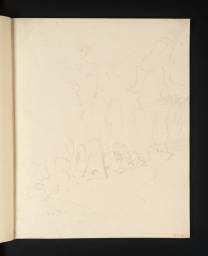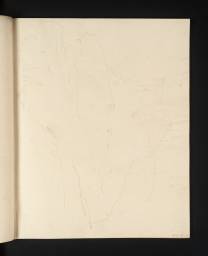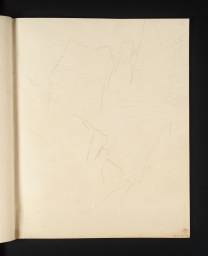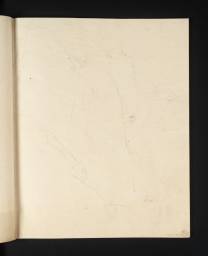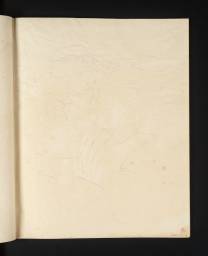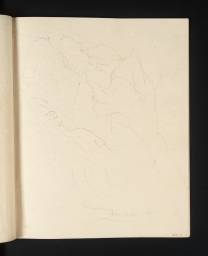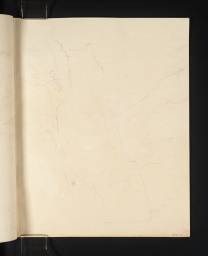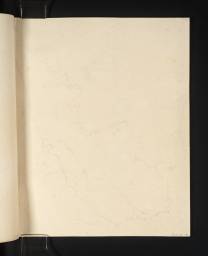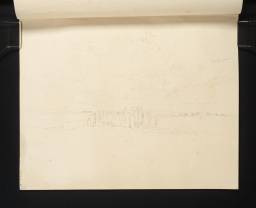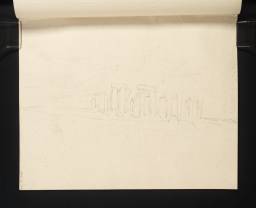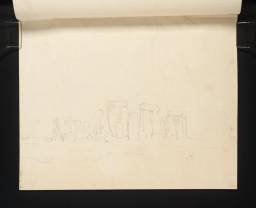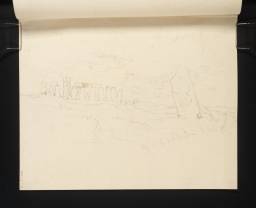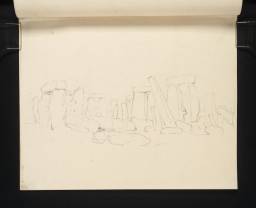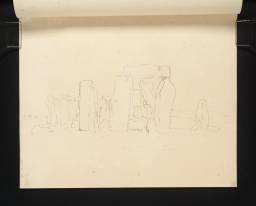Turner Bequest CXXV b 1–15
Sketchbook bound in thin, light brown, modern card covers
15 leaves of white wove paper tipped onto custom-made white paper stubs between modern cream free endpapers folded double at each end of the book, approximate page size 222 x 180 mm (222 x 198 mm including stub)
Makers unidentified; various leaves watermarked ‘H | 1808’
No numbering as part of the Turner Schedule in 1854 or endorsement by the Executors of the Turner Bequest evident; inscribed in pencil on the front cover ‘TURNER BEQUEST | CXXV b’ top right and on the front free endpaper ‘Add. CXXV. B.’ top right
15 leaves of white wove paper tipped onto custom-made white paper stubs between modern cream free endpapers folded double at each end of the book, approximate page size 222 x 180 mm (222 x 198 mm including stub)
Makers unidentified; various leaves watermarked ‘H | 1808’
No numbering as part of the Turner Schedule in 1854 or endorsement by the Executors of the Turner Bequest evident; inscribed in pencil on the front cover ‘TURNER BEQUEST | CXXV b’ top right and on the front free endpaper ‘Add. CXXV. B.’ top right
Accepted by the nation as part of the Turner Bequest 1856
References
This so-called ‘sketchbook’ (see the technical notes below) comprises multiple views of just two sites visited towards the end of Turner’s 1811 tour of the West Country: Cheddar Gorge in Somerset and Stonehenge in Wiltshire. It was not recorded in Finberg’s 1909 Turner Bequest Inventory,1 but pseudo-Finberg numbers for this and the Cornwall and Devon ‘sketchbook’ (Tate; Turner Bequest CXXV a) have since placed them in sequence with the other sketchbooks in use on the same trip, as described in the introduction to the tour. For convenience of reference, the Stonehenge and Cornwall and Devon books and their contents will generally be described in the present catalogue as sketchbooks without qualification.
The rectos of folios 1–8 (D41374–D41381), showing the western part of Cheddar Gorge, are the only views of this feature so far identified, and Turner does not seem to have developed the subject further. There is a sketch from Cheddar to the sea in the contemporary Devonshire Coast, No.1 sketchbook (Tate D08592; Turner Bequest CXXIII 118), where there are also views of nearby Glastonbury (Tate D08595, D08681, D08682; Turner Bequest CXXIII 119a, 167a, 168).
The rectos of folios 9–15 (D41382–D41388) form a series of careful studies of Stonehenge, the most famous prehistoric monument in Britain, which had been and has remained an inspiration for many artists,2 including Turner’s contemporary John Constable.3 The sketches here are datable by association with those in Devonshire Coast, No.1 (Tate D08749–D08752; Turner Bequest CXXIII 211a, 212, 212a, 213); elsewhere in the same book (Tate D08415; Turner Bequest CXXIII 29), Turner wrote in verse of the ‘bleak expanse of Sarum [i.e. Salisbury] plain’
Where mouldring tumuli sepulchral steep
Gives but a niggard shelter een to sheep
Gives but a niggard shelter een to sheep
He had first shown interest in Stonehenge in the Studies for Pictures sketchbook, in use a decade or so before the 1811 tour, with a distant view (Tate D04046; Turner Bequest LXIX 42) and two close-up studies (Tate D04090, D04092; Turner Bequest LXIX 79, 80a). Although it has been suggested that these are based on unspecified prints,4 they appear quite accurate and imply direct observation, possibly on a Wiltshire visit in connection with commissions from Turner’s early patrons William Beckford or Sir Richard Colt Hoare.5
A subsequent watercolour of Stonehenge at Sunset (private collection)6 shows a specific view from the east, with the Warminster and Wincanton roads forking north and south of Stonehenge from a signpost on the Amesbury road in the foreground, but with the stones themselves shown without any attempt at accuracy. It has been dated to within a year or two of Turner’s 1811 tour,7 and in view of its similar dimensions it has been suggested that it was made on a sheet of the paper comprising the present sketchbook.8 However, it relates closely to one of the Devonshire Coast, No.1 sketches (Tate D08752; Turner Bequest CXXIII 213), presumably made on the same occasion as the studies here, and was in all probability painted in the studio rather than on the spot. There is a lone figure by the signpost, and pale shapes in the gloaming nearby might indicate sheep.
There is a ‘colour beginning’ (Tate D25123; Turner Bequest CCLXIII 1) showing only billowing clouds and sheep-like shapes on a plain devoid of stones, in preparation for Turner’s watercolour of Stonehenge of about 1827 (Salisbury and South Wiltshire Museum),9 engraved as Stone Henge for the Picturesque Views in England and Wales in 1829 (Tate impressions: T04548, T04549, T06083). Curiously, as has been noted elsewhere,10 this dramatic rendition of the monument in a thunder-storm, with a shepherd and his flock struck by lightning, is crowded with inaccurately drawn stones, bearing a very inexact resemblance to the place and to the attentive drawings catalogued here.
The watercolour traditionally know as Stonehenge at Daybreak (Museum of Fine Arts, Boston) has been dated to about 1824 by Gillian Forrester,11 and is a monochrome wash study for an unpublished Liber Studiorum engraving. It might equally well be a sunset scene, as the alignment of the stones is again imprecise and the road in the foreground only roughly indicated. Sheep and figures are shown in the foreground, passed by a coach and horses.
Another watercolour view of the monument with sheep and a single figure is Stonehenge – Modern Chronology (private collection), made for Walter Fawkes in about 1822 along with a companion view of The Pyramids – Ancient Chronology (private collection) as frontispieces for albums.12 The sun is shown very low, presumably setting beyond an unrealistically wide gap between the stones. The disregard for accuracy in favour of mood makes the intended orientation a matter of guesswork. The single stone leaning to the right in the centre is seen at a similar angle in the view to the west, with what seems to be the setting sun, on folio 10 recto of the present book (D41383), where it is partly hidden behind a trilithon, but any slight similarity in the compositions is probably fortuitous.
See Christopher Chippindale, ‘Stonehenge Observed’ in Visions of Stonehenge 1350–1987, exhibition catalogue, Southampton City Art Gallery 1987; and Mike Pitts, ‘Stonehenge’ in David Gaimster, Sarah MacCarthy and Bernard Nurse (eds.), Making History: Antiquaries in Britain 1707–2007, exhibition catalogue, Royal Academy, London 2007, pp.[225]–53.
Not in Wilton 1979; see Ian Warrell (ed.), Franklin Kelly and others, J.M.W. Turner, exhibition catalogue, National Gallery of Art, Washington 2007, p.82 no.47, reproduced (colour).
See 115th Annual Exhibition of Watercolours and Drawings, exhibition catalogue, Thos Agnew & Sons, London 1988, p.[18], reproduced; and Ian Warrell in Warrell (ed.) 2007, p.82.
Not in Wilton 1979; Gillian Forrester, Turner’s ‘Drawing Book’: The Liber Studiorum, exhibition catalogue, Tate Gallery, London 1996, p.145 no.81i, reproduced.
Technical notes
How to cite
Matthew Imms, ‘Stonehenge sketchbook 1811’, sketchbook, May 2010, in David Blayney Brown (ed.), J.M.W. Turner: Sketchbooks, Drawings and Watercolours, Tate Research Publication, December 2012, https://www

